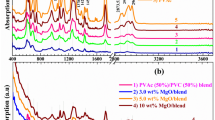Abstract
This work reports the synthesis, characterization, and antimicrobial activity of polyaniline/polyvinyl alcohol (PANI/PVA) and polydiphenylamine/polyvinyl alcohol (PDPA/PVA) co-polymer nanocomposite films. Initially, chemical oxidative polymerization was employed to synthesis PANI and PDPA by oxidizing aniline (AN) and diphenylamine (DPA) in the presence of ammonium peroxydisulfate (APS) as an oxidant. A trace amount of prepared PANI and PDPA were used to prepare nanocomposite films by solution casting technique, using PVA as a stabilizer. Surface morphological studies reveal the impregnated amorphous structure of PANI and PDPA size in the range of ~ 50–150 nm. Fourier transform infrared (FTIR) examines to confirm the presence of PANI, PDPA, and PVA in nanocomposite film. Disk diffusion approach was adopted to study the antimicrobial activity of PANI/PVA and PDPA/PVA nanocomposite films.






Similar content being viewed by others
References
Tan, S., Li, G., Shen, J., Liu, Y., & Zong, M. (2000). Study of modified polypropylene nonwoven cloth. II. Antibacterial activity of modified polypropylene nonwoven cloths. Journal of Applied Polymer Science, 77(9), 1869–1876.
Kenawy, E. R., Abdel-Hay, F. I., El-Shanshoury, A. E. R. R., & El-Newehy, M. H. (2002a). Biologically active polymers. V. Synthesis and antimicrobial activity of modified poly (glycidyl methacrylate-co-2-hydroxyethyl methacrylate) derivatives with quaternary ammonium and phosphonium salts. Journal of Polymer Science Part A: Polymer Chemistry, 40(14), 2384–2393.
Hirano, S., & Nagao, N. (1989). Effects of chitosan, pectic acid, lysozyme, and chitinase on the growth of several phytopathogens. Agricultural and Biological Chemistry, 53(11), 3065–3066.
Guo, Z., Xing, R., Liu, S., Zhong, Z., Ji, X., Wang, L., & Li, P. (2007). Antifungal properties of Schiff bases of chitosan, N-substituted chitosan and quaternized chitosan. Carbohydrate Research, 342(10), 1329–1332.
da Silva, C. M., da Silva, D. L., Modolo, L. V., Alves, R. B., de Resende, M. A., Martins, C. V., & de Fátima, Â. (2011). Schiff bases: a short review of their antimicrobial activities. Journal of Advanced Research, 2(1), 1–8.
Irimia-Vladu, M., & Fergus, J. W. (2006). Suitability of emeraldine base polyaniline-PVA composite film for carbon dioxide sensing. Synthetic Metals, 156(21), 1401–1407.
Patil, D. S., Shaikh, J. S., Dalavi, D. S., Kalagi, S. S., & Patil, P. S. (2011). Chemical synthesis of highly stable PVA/PANI films for supercapacitor application. Materials Chemistry and Physics, 128(3), 449–455.
Hou, W., Xiao, Y., Han, G., Fu, D., & Wu, R. (2016). Serrated, flexible and ultrathin polyaniline nanoribbons: an efficient counter electrode for the dye-sensitized solar cell. Journal of Power Sources, 322, 155–162.
Gizdavic-Nikolaidis, M. R., Bennett, J. R., Swift, S., Easteal, A. J., & Ambrose, M. (2011). Broad spectrum antimicrobial activity of functionalized polyanilines. Acta Biomaterialia, 7(12), 4204–4209.
Jia, Q., Shan, S., Jiang, L., Wang, Y., & Li, D. (2012). Synergistic antimicrobial effects of polyaniline combined with silver nanoparticles. Journal of Applied Polymer Science, 125(5), 3560–3566.
Lashkenari, M. S., & Eisazadeh, H. (2016). Enhanced functionality of colloidal polyaniline/polyvinyl alcohol nanocomposite as an antibacterial agent. Journal of Vinyl and Additive Technology, 22(3), 267–272.
Ghaffari-Moghaddam, M., & Eslahi, H. (2014). Synthesis, characterization and antibacterial properties of a novel nanocomposite based on polyaniline/polyvinyl alcohol/Ag. Arabian Journal of Chemistry, 7(5), 846–855.
Hua, F., & Ruckenstein, E. (2004). Fluorescence study of aggregation in water of PEO-grafted polydiphenylamine. Langmuir, 20(10), 3954–3961.
Ragupathy, D., Gopalan, A. I., & Lee, K. P. (2009). Layer-by-layer electrochemical assembly of poly (diphenylamine)/phosphotungstic acid as ascorbic acid sensor. Microchimica Acta, 166(3–4), 303–310.
Tsai, Y. T., Wen, T. C., & Gopalan, A. (2003). Tuning the optical sensing of pH by poly (diphenylamine). Sensors and Actuators B: Chemical, 96(3), 646–657.
Ragupathy, D., Gomathi, P., Lee, S. C., Al-Deyab, S. S., Lee, S. H., & Do Ghim, H. (2012). One-step synthesis of electrically conductive polyaniline nanostructures by oxidative polymerization method. Journal of Industrial and Engineering Chemistry, 18(4), 1213–1215.
Wang, H., Wen, H., Hu, B., Fei, G., Shen, Y., Sun, L., & Yang, D. (2017). Facile approach to fabricate waterborne polyaniline nanocomposites with environmental benignity and high physical properties. Scientific Reports, 7, srep43694.
Trchová, M., & Stejskal, J. (2011). Polyaniline: The infrared spectroscopy of conducting polymer nanotubes (IUPAC technical report). Pure and Applied Chemistry, 83(10), 1803–1817.
Ghobadi, S., Mehraeen, S., Bakhtiari, R., Shamloo, B., Sadhu, V., Papila, M., & Gürsel, S. A. (2016). PVA/PANI/rGO ternary electrospun mats as metal-free anti-bacterial substrates. RSC Advances, 6(95), 92434–92442.
Wen, T. C., Sivakumar, C., & Gopalan, A. (2002). Studies on processable conducting blend of poly (diphenylamine) and poly (vinylidene fluoride). Materials Letters, 54(5), 430–441.
Kohanski, M. A., Dwyer, D. J., & Collins, J. J. (2010). How antibiotics kill bacteria: from targets to networks. Nature Reviews Microbiology, 8(6), 423–435.
Qazi, T. H., Rai, R., & Boccaccini, A. R. (2014). Tissue engineering of electrically responsive tissues using polyaniline based polymers: a review. Biomaterials, 35(33), 9068–9086.
Riaz, U., & Ashraf, S. M. (2013). Evaluation of antibacterial activity of nanostructured copolymers of poly (naphthylamine). International Journal of Polymeric Materials and Polymeric Biomaterials, 62(7), 406–410.
Acknowledgements
The authors acknowledge the basic research support from National Institute of Technology Puducherry, Karaikal, India.
Funding
This study is supported by the Science and Engineering Research Board—Department of Science Technology grant (SB/FT/CS-117/2014).
Author information
Authors and Affiliations
Corresponding author
Rights and permissions
About this article
Cite this article
Muthusankar, E., Vignesh Kumar, S., Rajagopalan, N. et al. Synthesis and Characterization of Co-Polymer Nanocomposite Film and its Enhanced Antimicrobial Behavior. BioNanoSci. 8, 1008–1013 (2018). https://doi.org/10.1007/s12668-018-0564-x
Published:
Issue Date:
DOI: https://doi.org/10.1007/s12668-018-0564-x



